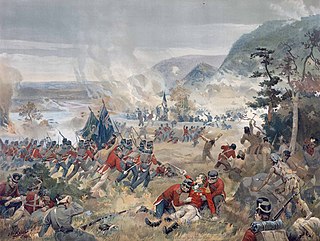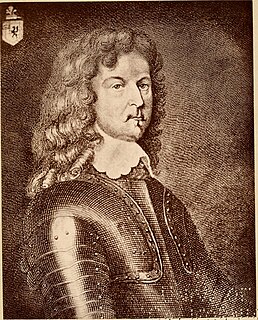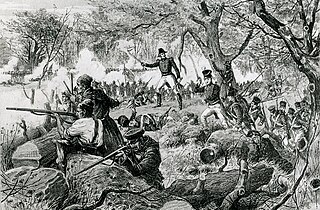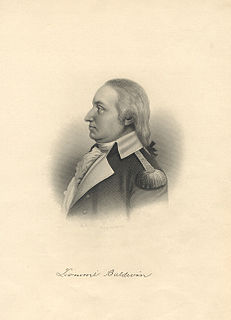This article relies too much on references to primary sources .(February 2011) (Learn how and when to remove this template message) |

This article relies too much on references to primary sources .(February 2011) (Learn how and when to remove this template message) |

Sir Henry Bard's Regiment of Foote was a northern unit, originally called Colonel Thomas Pinchbeck's Regiment of Foote. Raised in Northumberland. It arrived in Oxford in May 1643 under the command of Colonel Thomas Pinchbeck. Half of Pinchbeck's regiment was split from the regiment under Bard's command to form Lord Percy's Foote. Pinchbeck was killed at the first battle of Newbury, and Bard took control of Pinchbeck's half of the regiment, hence the name change. The regiment's first major conflict under its new commanding officer was at Cheriton Wood. It was a disaster; records suggest that a week later the regiment numbered 176 men. The regiment later fought at the battles of Cropredy Bridge, Lostwithiel and Second Newbury, before being reinforced by the Queen's Lifeguard and forming the garrison of Campden House.
Henry Percy, Baron Percy of Alnwick, son of Henry Percy, 9th Earl of Northumberland, sat in the Short Parliament as the member for Portsmouth, and in the Long Parliament an M.P. for Northumberland; an originator of the "first army plot" in 1641, after which he retired to France. He was appointed general of the ordnance of the king's army and created baron, 1643; but fell in disgrace in 1644 through his desire for peace. In 1648 he resigned his command and went to France where he joined Queen Henrietta Maria's party. He died in France around March 1659.

The First Battle of Newbury was a battle of the First English Civil War that was fought on 20 September 1643 between a Royalist army, under the personal command of King Charles, and a Parliamentarian force led by the Earl of Essex. Following a year of Royalist successes in which they took Banbury, Oxford and Reading without conflict before storming Bristol, the Parliamentarians were left without an effective army in the field. When Charles laid siege to Gloucester, Parliament was forced to muster a force under Essex with which to beat Charles' forces off. After a long march, Essex surprised the Royalists and forced them away from Gloucester before beginning a retreat to London. Charles rallied his forces and pursued Essex, overtaking the Parliamentarian army at Newbury and forcing them to march past the Royalist force to continue their retreat.

The Battle of Cheriton was an important Parliamentarian victory in the English Civil War. It took place on 29 March 1644 and resulted in the defeat of a Royalist army, which threw King Charles I onto the defensive for the remainder of the year.
It is possible that they may also at this time have become an all musketeer unit, as was normal with garrisons and firelock muskets were certainly issued. Originally they wore grey or white coats but it is possible that red coats may have been issued at this time. The unit was finally destroyed at the Battle of Naseby; all of its colours were captured. [1]

The Battle of Naseby was a decisive engagement of the First English Civil War, fought on 14 June 1645 between the main Royalist army of King Charles I and the Parliamentarian New Model Army, commanded by Sir Thomas Fairfax and Oliver Cromwell. It was fought near the village of Naseby in Northamptonshire.
The present day regiment has two companies: Captain Errington's Companye, based mainly in Essex but also having members as far a field as Ipswich and Devon and The Major's Companye, based mainly around Basingstoke. The regiment consists of pike, musket, drums, ensigns, artillery and camp followers. There are also two cannons within the regiment: Donna and Lizzy B. [2]

The New Model Army of England was formed in 1645 by the Parliamentarians in the English Civil War, and was disbanded in 1660 after the Restoration. It differed from other armies in the series of civil wars referred to as the Wars of the Three Kingdoms in that it was intended as an army liable for service anywhere in the country, rather than being tied to a single area or garrison. Its soldiers became full-time professionals, rather than part-time militia. To establish a professional officer corps, the army's leaders were prohibited from having seats in either the House of Lords or House of Commons. This was to encourage their separation from the political or religious factions among the Parliamentarians.

The Battle of Queenston Heights was the first major battle in the War of 1812. Resulting in a British victory, it took place on 13 October 1812, near Queenston, Upper Canada. It was fought between United States regulars and New York militia forces led by Major General Stephen Van Rensselaer, and British regulars, York and Lincoln militia and Mohawk warriors led by Major General Isaac Brock, and Major General Roger Hale Sheaffe, who took command when Brock was killed.
The Irish Brigade was an infantry brigade, consisting predominantly of Irish Americans, that served in the Union Army in the American Civil War. The designation of the first regiment in the brigade, the 69th New York Infantry, or the "Fighting 69th", continued in later wars. The Irish Brigade was known in part for its famous war cry, the "Faugh a Ballaugh", which is an anglicization of the Irish phrase, fág an bealach, meaning "clear the way". According to Fox's Regimental Losses, of all Union army brigades, only the 1st Vermont Brigade and Iron Brigade suffered more combat dead than the Irish Brigade during America's Civil War.

Sir John Boys is best known as the Royalist Governor of Donnington Castle in Berkshire during the English Civil War.
The 2nd New Hampshire Regiment was formed in early May 1775, as the second of three Continental Army regiments raised by the state of New Hampshire during the American Revolutionary War. Its first commander was Colonel Enoch Poor, with Joseph Cilley as major. Many of the men who served in the unit hailed from southeastern New Hampshire and western Maine. During the first part of its service, the regiment took part in the siege of Boston, and there is a link below in the reference section to the orderly book of an officer in the unit during that time.
The 1st Pennsylvania Regiment - originally mustered as the 1st Pennsylvania Rifles; also known as the 1st Continental Line and 1st Continental Regiment, was raised under the command of Colonel William Thompson for service in the Continental Army.

When the United States and the United Kingdom went to war against each other in 1812, the major land theatres of war were Upper Canada, Michigan Territory, Lower Canada and the Maritime Provinces of Nova Scotia, New Brunswick, Prince Edward Island and Cape Breton . Each of the separate British administrations formed regular and fencible units, and both full-time and part-time militia units, many of which played a major part in the fighting over the two and a half years of the war.

Fort Reno also known as Fort Connor or Old Fort Reno, was a wooden Fort established on August 15, 1865 by the United States Army in Dakota Territory in present-day Johnson County, Wyoming. The fort was built to protect travelers on the Bozeman Trail from Native American tribes.
Henry Bard, 1st Viscount Bellomont was an English Royalist.
Thomas Wentworth, KB, PC was an English soldier and politician who supported King Charles I in the English Civil War. He served the king during two parts of the English Civil War and accompanied the young Prince Charles in exile.
The 62nd (Wiltshire) Regiment of Foot was an infantry regiment of the British Army, which was raised in 1756 and saw service through the eighteenth and nineteenth centuries. Under the Childers Reforms it amalgamated with the 99th (Lanarkshire) Regiment of Foot to form the Wiltshire Regiment in 1881.
The 88th New York Infantry was a volunteer regiment in the Union Army's Irish Brigade during the American Civil War.
The Thirteenth Pennsylvania Reserve Regiment, also known as the 42nd Pennsylvania Volunteer Infantry, the 1st Pennsylvania Rifles, Kane's Rifles, or simply the "Bucktails," was a volunteer infantry regiment that served in the Union Army during the American Civil War. It was a part of the famed Pennsylvania Reserve division in the Army of the Potomac for much of the early and middle parts of the war, and served in the Eastern Theater in a number of important battles, including Antietam, Fredericksburg, and Gettysburg.
The Glengarry Light Infantry Fencibles were a light infantry unit, raised chiefly in the Glengarry District of Upper Canada shortly before the outbreak of the Anglo-American War of 1812. The unit fought throughout the war, and was disbanded shortly afterwards.
The 16th New York Volunteer Infantry was an infantry regiment in the Union Army during the American Civil War.

The 26th Continental Regiment was an infantry unit of the Massachusetts Line during the American Revolutionary War. Gerrish's Regiment was raised in the early days of the war, and the regiment underwent name changes as the Continental Army was reorganized in 1776 and 1777. From 1777 onward, the unit was known as the 9th Massachusetts Regiment.

The Sicilian Regiment was a light infantry regiment recruited from Sicily that served with the British Army during the Napoleonic wars, from 1806 to its disbandment in 1816.

The Regiment of Riflemen was a unit of the U.S. Army in the early nineteenth century. It was first activated in 1808. During the War of 1812, it was temporarily designated as the 1st Regiment of Riflemen when the War Department created three additional similar regiments. The regiment never fought as a unit. Companies, detachment from companies or collections of companies were stationed at a distance from each other and were often allocated to other commands. After the War, the other three regiments were inactivated and the regiment reverted to its unnumbered designation. The regiment was inactivated in June 1821.
Where can you find troops more efficient than Morgan's riflemen of the Revolution or Forsyth's riflemen of the last war with Great Britain?

The 1st Arkansas Cavalry Battalion (Stirman's) (1864-1865) was a Confederate Army cavalry battalion during the American Civil War. The unit was also known as Brooks 1st Arkansas Cavalry Battalion, Stirman's, 1st Arkansas Cavalry Battalion, Stirman's Sharpshooter Regiment, 1st Regiment Arkansas Sharpshooters, and finally simply as Stirman's Arkansas Cavalry Regiment.